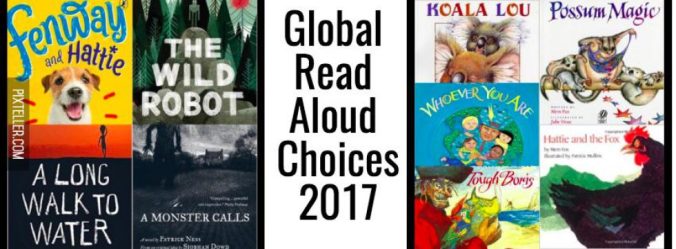
Pernille Ripp is an education goddess. She saw a need for kids to connect with books and with each other, and she created the Global Read Aloud in 2010. The GRA is about a month long, incorporates really good literature and global connections to others reading the same book(s), and is very low key. There’s no pressure to go all-in with your participation; your level of involvement is whatever you want it to be. If you feel the need to connect books and kids and kids from other places, read on!
After a months-long vetting process (all done by Pernille Ripp herself!), books are chosen in five categories: primary grades author study, primary grades chapter book, upper elementary chapter book, middle grade chapter book, and young adults chapter book. You can choose any of the books based on the level or needs of your students, and, if you get in on it early enough, you can recommend books!

This year’s books!
I’ve participated in the GRA for the past two years, and I love the way it’s presented. If you’re new, you can keep to your classroom and discuss the book there. If you’re feeling more chatty, you can get on to Twitter and hashtag the book you’re reading. If you’re feeling really ambitious, a group of teachers last year and this year (and maybe before!) have created hyperdocs for the books in order to get kids thinking deeply about what they’re hearing/reading. There are also Edmodo groups where you can connect with other classrooms around the world, as well as Facebook, Pinterest, and WriteAbout.
I’ve participated in both the author study (Peter Reynolds in 2015) and the upper elementary chapter book (Pax in 2016), and I would highly encourage this method of getting connected to other classrooms. Our Twitter responses to the text last year generated questions from other classrooms, Mystery Hangouts, and a general feeling that we were not alone in our 4th grade universe. I attempted to use the hyperdoc last year, but found it too much to manage in the way I presented it. I’ll use some of what is available this year, but try not to overwhelm my students with too much!
At the end of last year, I started reading The Wild Robot to my class. We didn’t make it through, but were already having deeper discussions about the text, and students were begging for more chapters each day. Which is another thing I love about the GRA – it puts on my radar books I might not pick up normally that kids will really get involved in. Granted, just the title is intriguing, and I love what I’ve seen of Peter Brown’s work already. I can’t wait to share it with my new crop of kids, and to connect with other classrooms worldwide.
If you’re interested in participating in the GRA, you can sign up here. Maybe I’ll see you on Twitter!
**Many thanks to the GRA website for the images in this post!**
 Dedra Downing is a 24 year veteran teacher in California. She has taught primary grades. She has a Bachelors in Child Development and Masters in Educational Administration. She enjoys playing her harp, crocheting, and creating lessons that inspire her students to grow.
Dedra Downing is a 24 year veteran teacher in California. She has taught primary grades. She has a Bachelors in Child Development and Masters in Educational Administration. She enjoys playing her harp, crocheting, and creating lessons that inspire her students to grow.

 We bit the bullet this week and hired a professional housecleaning service. Our time seems to be dwindling away now that the girls are older, and it seemed like the right time. After a few hours of “straightening”, I felt like the house looked good enough to have someone else come in and take care of the rest. Although the consensus from the smaller people was that it now looked “weird” (read: no visible signs of children living in the house, i.e. Barbies, bits of paper, and Lego everywhere), I found myself more relaxed already.
We bit the bullet this week and hired a professional housecleaning service. Our time seems to be dwindling away now that the girls are older, and it seemed like the right time. After a few hours of “straightening”, I felt like the house looked good enough to have someone else come in and take care of the rest. Although the consensus from the smaller people was that it now looked “weird” (read: no visible signs of children living in the house, i.e. Barbies, bits of paper, and Lego everywhere), I found myself more relaxed already.





 and
and


